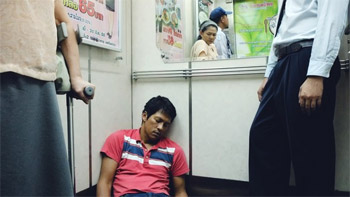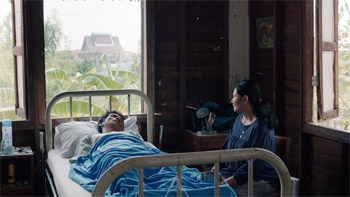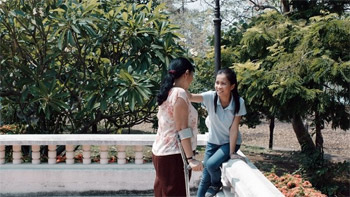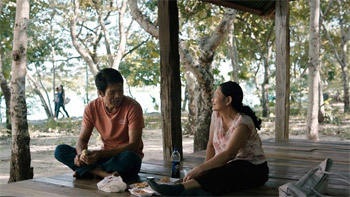Apichatpong Weerasethakul Cemetery of Splendour Interview

Apichatpong Weerasethakul Cemetery of Splendour Interview
Cast: Jenjira Pongpas, Banlop Lomnoi, Jarinpattra Rueangram
Director: Apichatpong Weerasethakul
Genre: Drama
Running Time: 122 minutes
Synopsis: Soldiers with a mysterious sleeping sickness are transferred to a temporary clinic in a former school. The memory-filled space becomes a revelatory world for housewife and volunteer Jenjira, as she watches over Itt, a handsome soldier with no family visitors. Jen befriends young medium Keng who uses her psychic powers to help loved ones communicate with the comatose men. Doctors explore ways, including coloured light therapy, to ease the mens' troubled dreams. Jen discovers Itt's cryptic notebook of strange writings and blueprint sketches. There may be a connection between the soldiers' enigmatic syndrome and the mythic ancient site that lies beneath the clinic. Magic, healing, romance and dreams are all part of Jen's tender path to a deeper awareness of herself and the world around her.
Cemetery of Splendour
Release Date: January 11th, 2016
Interview with Apichatpong Weerasethakul
Question: Cemetery of Splendour is set in Khon Kaen, your home town. You've written of the film being 'a personal portrait of places that have latched onto you like parasites". How are these places so personal to you?
Apichatpong Weerasethakul: The film is a search for the old spirits I knew as a child. My parents were doctors and we lived in one of the hospital housing units. My world was the patients' ward where my mother worked, our wood house, a school, and a cinema. The film is a merging of these places. I haven't lived in my home town for almost 20 years. The city has changed so much. But when I went back I only saw my old memories superimposed on t he new buildings. However one of my favourite spots, the Khon Kaen lake, remains the same.
he new buildings. However one of my favourite spots, the Khon Kaen lake, remains the same.
Question: You mention your upbringing in a hospital environment. How has this influenced your films with their focus on medical equipment and your pre-occupation with illness?
Apichatpong Weerasethakul: For me, listening to heartbeats through a stethoscope or using a magnifying glass with a light was already magic. On rare occasions I was treated with a view through a microscope. Another exciting memory was to watch 16mm films at the American institution in Khon Kaen. They had bases in the northeast during that time to counter communism. I remember very well the black and white King Kong, among other films. The movies and medical tools were the best of inventions for my childhood.
Question: Where did this idea of telling the story of the sleeping men come from? What first drew you to this mysterious sleeping? A true story?
Apichatpong Weerasethakul: There was a news story 3 years ago about a hospital in the north, where there was a mysterious disease that forced the hospital to quarantine 40 soldiers. I merged the image of the soldiers together with my hospital and my school in Khon Kaen. Over those three years, the political situation in Thailand had come to a dead end (up to the present actually). I was fascinated with sleeping and jotted down my dreams. I think it is a way to escape the terrible situations on the streets.
Question: Is the coloured light treatment based on any sort of actual treatment? It also seems to come from your interest in science fiction.
Apichatpong Weerasethakul: At one point I was reading articles about brain science. There was an MIT professor who manipulated brain cells into re-enacting certain memories, via lights. He said that the findings sort of disproved Descartes' belief that the mind and the body are separate entities. This hypothesis aligned with my thinking that meditation is nothing more than a biological process. Sleep and memory can always be hacked into. If I were a doctor I would try to cure sleeping sickness by light interference at a cellular level. The lights in this film vaguely reflect this idea. They are not only for the soldiers but also for the audience as well.  Question: Jenjira discovers Itt's notebook with its strange drawings and plans. There are real spaces that we see in the film, but equally -present' are others spaces, a mythological space of a palace and a cemetery.
Question: Jenjira discovers Itt's notebook with its strange drawings and plans. There are real spaces that we see in the film, but equally -present' are others spaces, a mythological space of a palace and a cemetery.
Apichatpong Weerasethakul: When we were young we were told about this most amazing place where the water is full of fish and the land covered in rice fields. The signs of wealth were always idyllic, omitting the brutalities. We have this burden of fabricated history. It effects generations: how do we view ourselves? With the information that is surfacing and recent studies, our sense of identity is shifting. I think the film plays with this shaky sense of belonging.
Question: Could you say a little about the Jenjira's journey through the film? You have worked regularly with her in your films but here she has an even more central role than in the past ...
Apichatpong Weerasethakul: We started working together on Blissfully Yours (2002). After that she hung out at our office a lot. I loved her personality, her daughters, and her stories. She has a brain that I wish I had, a brain that remembers everything. I think she can recall what we had for lunch on what particular shooting day, 10 years ago, for example. So we worked together on numerous projects including a book with her writings. She inspired me to learn more about Isan's history. As it developed, this film became my dream, hers, and a little bit of what I imagine of my mother's.
Question: Most of the cast are from Isan and the film is largely spoken in Isan dialect. Are there particular traditions and beliefs peculiar to Isan as against Thailand as a whole?
Apichatpong Weerasethakul: Isan area used to be made up of different empires – Cambodia, Lan Chang (Laos). This was until the unification (or Thaification) when the Bangkok authority took over the northeast. My family moved there from Bangkok a few years before I was born. It is a dry place, not as splendorous as the central plains (where Bangkok is). However to me it is very colourful because of the trace of the Khmers' animism. So people are not only living in an everyday life world, but a spiritual world as well. Simple things can be magical.
Question: Could you say something about your casting. You work regularly with the same actors, like Jenjira, but also seek out non-professionals.
Apichatpong Weerasethakul: Because the film was shot in Khon Kaen, we did a casting session in town. I was happily surprised to see so many talents. There are also several young, enthusiastic filmmakers. To me making this film was like making a first film. I tried to throw away some of my restrictions on filmic styles and embraced the town's energy. Working with the non-professionals helped me find the rhythm.
Question: On this occasion, the one exception was your Director of Photography Diego Garcia, who you worked with for the first time.
Apichatpong Weerasethakul: Mr. Miguel Gomes stole away my regular DoP to Portugal, to make his impossibly long film, (Arabian Nights – Volume 2, The Desolate Ones). I was happy for him because Gomes is one of the best. But I was troubled. So I asked around for suggestions. Carlos Reygadas introduced me to Diego who is likely to work on Carlos' next film. So I might be Carlos' guinea pig. I am very happy with the experience, of course. What I admire most about Diego is his personality. Besides being very talented, he is very calm. I don't like it when there is yelling on the set (mine included). All the crew love him. After a few days of shooting I felt like I had worked with him for a long time. For this film I preferred natural light, I wanted a shade of melancholy. He has delivered beautifully.
 Question: In some ways, this film is closer to a linear narrative than your other films.
Question: In some ways, this film is closer to a linear narrative than your other films.
Apichatpong Weerasethakul: As with my other films, the development of Cemetery of Splendour was very organic. I observed my dreams and thought that they were quite narrative, more than my own films. I give equal importance to my dream as to my waking experience. In retrospect, Cemetery … can be a dream of being awake or a reality that is seemingly like a dream.
Question: You have described the film as, 'a rumination on Thailand, a feverish nation"?
Cemetery of Splendour
Release Date: January 11th, 2016
MORE
- Mission: Impossible Fallout
- Glenn Close The Wife
- Allison Chhorn Stanley's Mouth Interview
- Benicio Del Toro Sicario: Day of the Soldado
- Dame Judi Dench Tea With The Dames
- Sandra Bullock Ocean's 8
- Chris Pratt Jurassic World: Fallen Kingdom
- Claudia Sangiorgi Dalimore and Michelle Grace...
- Rachel McAdams Disobedience Interview
- Sebastián Lelio and Alessandro Nivola...
- Perri Cummings Trench Interview



